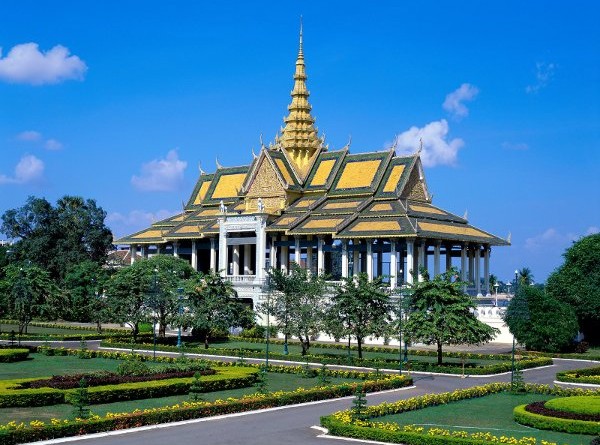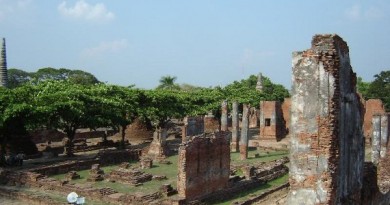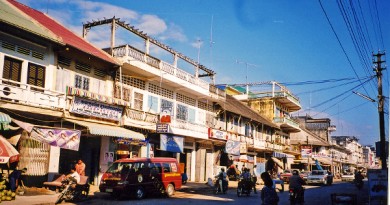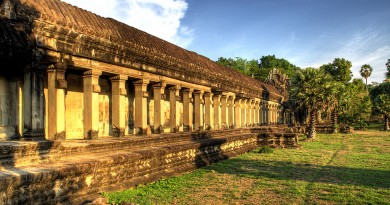Phnom Penh in Cambogia
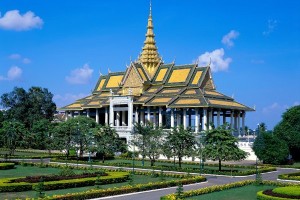 Phnom Penh is the capital of Cambodia, located at the confluence of three rivers – the Mekong, Tonle Sap and Bassac. It is an ancient city, the first mention of which belong to the XIV century. In 1443, and according to some, in 1446, became the capital of Phnom Penh Cambodian kingdom. Although, sometimes the residence of the kings at the time moved to other cities, Phnom Penh always maintained the status most important economic center of the country.
Phnom Penh is the capital of Cambodia, located at the confluence of three rivers – the Mekong, Tonle Sap and Bassac. It is an ancient city, the first mention of which belong to the XIV century. In 1443, and according to some, in 1446, became the capital of Phnom Penh Cambodian kingdom. Although, sometimes the residence of the kings at the time moved to other cities, Phnom Penh always maintained the status most important economic center of the country.
Today, the nearly 1.5 million city is the capital of Cambodia, which gained independence in 1953. The legend has it that became the capital of Cambodia, Phnom Penh chance. According to popular legend once upon a time made the Mekong River to the shores of several statues of Buddha hidden in the branches of a fallen tree. They found a widow, whose name was Stump. The woman brought the statue home and as a religious custom ordered, to build for them a bit of an earthen pedestal, to put it simply – a hill. Hoisted on his relics became a local landmark, and the place was called “Phnom Penh”, which translated from Khmer means “hill Penh”.
At that time, the capital was the city of Angkor in Cambodia, often attacked militant Siamese tribes hostile to Cambodians. During a regular siege of the capital, the king, leaving his residence to the invaders, was forced to leave the city. On the way he saw a village in Phnom Penh, and he was spoken of her unusual story. The governor liked the location of the settlement, and the appearance of statues he’s just like the locals, considered divine sign. So is the small and nondescript village appeared majestic city – the capital of the Kingdom of Cambodia.
Phnom Penh is the city interesting and unusual stories. Throughout its existence, it has experienced many ups and downs. Completely destroyed in 1834 during the invasion by the Thais, it was rebuilt by the French, who returned the status of the capital city in 1866 th. Modern Phnom Penh today bears an indelible “French” imprint. Numerous buildings in colonial style decorate the city and make it a very unusual color. And the older generation that was born during the period of colonial existence, often good knowledge of French. Another upsurge of growth and development, as is the whole of Cambodia, has for the last decade. In the middle of the XX century, devastated and destroyed in a bloody political battle local parties, Phnom Penh seems rather pathetic.
Only in 1979, after the defeat of the “Khmer Rouge”, people began returning to their homes. Capital gradually takes on the form, worthy of its long glory, and today has little resemblance to the Phnom Penh ruins of thirty years ago. The original architecture and numerous monuments, combined with a mild subtropical climate and infrastructure make it an ideal place for the development of international tourism. Indeed, every year the number of tourists visiting the country has been steadily growing.
Climate in Cambodia – monsoons, the average annual temperature is in the range 24-28 ° C. The coldest month, when the temperature drops to +24-25 ° C – January. In July, the heat reaches 35 ° C. For the year in Cambodia falls about 1475 mm rainfall, 80% of which occur in the rainy season, which lasts from May to October. It is traditionally believed that the best time to visit the country is from November to April. However, Phnom Penh all year round is a haven for tourists from all over the world who come to look at the statue of the Buddha and lively city embankment.
The main attractions of Phnom Penh, which necessarily included in the program of excursions for visitors – the Royal Palace, the National Museum of Art, Silver Pagoda, and the Temple Mount Wat Phnom. Each of them is of interest, and each is given enough time to explore. The Royal Palace, located in the ancient citadel on the banks of the Mekong River, was built in 1866. Ruling at the time, King Norodom, was honored to receive a gift from the wife of Napoleon III – Empress Eugenie. The gift was a very unusual and has a luxurious royal apartments, bearing the name “Pavilion of Napoleon III». This pavilion, as well as the Throne Room and Yellow “Chan Chaya Pavilion”, built specially for the national dances, decorate the palace, and the pride of Cambodians.
The Silver Pagoda, also known as the Emerald Buddha Pagoda, is a complex of the Royal Palace. The splendor of this grand building deserves careful examination. Sex in the pagoda paved five thousand tiles of pure silver. Located in the heart of the Buddha statue is made of crystals bakarry differing beautiful emerald hue. The walls of buildings decorated with unique frescoes depicting various scenes from the Khmer history.
No less interesting to explore than the Royal Palace with its pavilions and statues, is the National Museum of Cambodia. One can only guess how Cambodians managed to keep a number of national relics in the most difficult period of history, but the collection really is one of the best in Asia. Especially noteworthy are made of sandstone sculptures Angkor and pre-Angkor period. Of interest and examples of contemporary Cambodian art.
But perhaps the most unusual tourist attraction in addition to exhibits of the museum are its living inhabitants. The world’s largest colony of bats ever settle in an artificial construction, lives under the roof of the museum. Should not be afraid of them, because the roof covering secure and to get inside the mouse can not. And enjoy the colony from possible only at dusk, when bats are leaving their homes, fly away to hunt.
As for the attractions of Wat Phnom, then you should already have guessed, this is a place where many centuries ago, the notorious widow found the statue of the Buddha, was the beginning of Phnom Penh. Today it is built the temple, where carefully preserved these ancient relics. You can see them every day for a nominal fee according to one USD. This place is one of the most popular holiday destinations of local residents. Here you can ride on an elephant and inexpensive meal.
As Phnom Penh is the major river port, accessible to ships, and also has an extensive rail network, it is natural that the industry and the trade is at a fairly high level. The city has businesses in ship repair and car assembly, factories food, textile, tobacco, wood and soap industries. Rice, sugar and palm oil, producing here, not only provide the needs of the country, but also for export. One of the objects of production and trade on the banks of local rivers is a variety of exotic fish, countless varieties that can be purchased at local grocery markets, or to order in restaurants, which are abundant in Phnom Penh. Incidentally, with regard to the local cuisine, it is also very diverse and includes not only Asian food but also a great selection of international dishes. In some institutions, held a kind of cooking classes, where anyone can get a full understanding of all the nuances of national Cambodian cuisine.
Lovers to spend their free time doing shopping, Phnom Penh is an excellent opportunity for this. Numerous shops and markets of the city with diverse range of products for every taste. Prices are acceptable, especially as Cambodians always bargained away and willingly lowers initially requested price. Especially known for the market-Thmey Dog, Dog-O-Rassi, Dog Chan. Here you can choose inexpensive antiques, traditional statues of marble and other souvenirs, without which one can not do any travel services.
If you prefer a higher level of product, in Phnom Penh, there are large shopping centers with air conditioning and a large selection of designer clothes. A modern 4 and 5-star hotels offer their guests a full range of services for your comfort.

